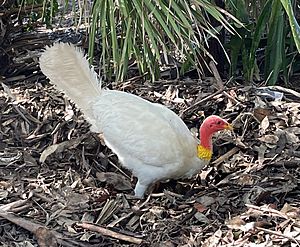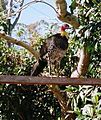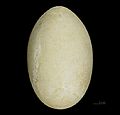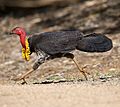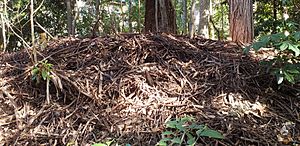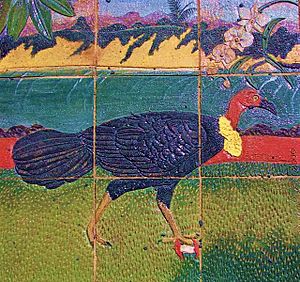Australian brushturkey facts for kids
Quick facts for kids Australian brushturkey |
|
|---|---|
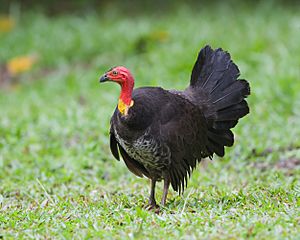 |
|
| Cairns, Queensland, Australia | |
| Conservation status | |
| Scientific classification | |
| Genus: |
Alectura
|
| Species: |
lathami
|
| Subspecies | |
|
|
The Australian brushturkey (Alectura lathami), also known as the scrub turkey or bush turkey, is a common bird found in eastern Australia. It lives from Far North Queensland down to the south coast of New South Wales. This bird has also been introduced to Kangaroo Island in South Australia.
The Australian brushturkey is a special type of bird called a "mound-builder." This means it builds large nests on the ground. It is the biggest mound-building bird in Australia. Even though it's called a "turkey," it's not closely related to the American turkey. Its closest relatives are other brushturkeys and the malleefowl.
Contents
About the Australian Brushturkey
What Does It Look Like?
The Australian brushturkey is a large bird with mostly black feathers. It has a bare red head. It grows to be about 60 to 75 centimeters (24 to 30 inches) long. Its wingspan is around 85 centimeters (33 inches).
One type of brushturkey from northern Queensland is smaller. Most brushturkeys have a yellow wattle, which is a fleshy flap of skin on their neck. The northern type has a purple wattle. During breeding season, the male's wattle gets much bigger and brighter. You might see it swinging as he runs!
The brushturkey has a unique, fan-like tail that is flattened sideways. Its body feathers are mostly black, but older birds have more white feathers on their underside. These birds are not very good at flying long distances. They usually only fly when they are in danger or when they go up into trees to sleep at night or rest during the hottest part of the day.
How Do They Build Nests?
Australian brushturkeys build huge nests on the ground. These nests are made from leaves, other rotting plant material, and earth. They can be 1 to 1.5 meters (3 to 5 feet) high and up to 4 meters (13 feet) across.
A dominant male brushturkey builds and looks after the nest. Females visit the nest to lay their eggs. The male works very hard to gather materials and keep other males away. This hard work eventually makes him tired, and a new male might take over his spot.
The eggs are very large, about 90 by 45 millimeters (3.5 by 1.8 inches). The young birds are fully developed when they hatch. They can even fly within hours of hatching, once their feathers are dry!
The eggs hatch because of the heat from the rotting material in the mound. The male brushturkey carefully controls the temperature of the mound. He adds or removes material to keep it between 33 and 35 degrees Celsius (91 to 95 degrees Fahrenheit). He checks the temperature by sticking his beak into the mound.
The temperature of the mound can affect whether more male or female chicks hatch. If the mound is cooler, more males might hatch. If it's warmer, more females might hatch. Warmer temperatures also lead to stronger, healthier chicks.
Brushturkeys often use the same nesting spot year after year. They just add to the old nests each breeding season. A typical nest has between 16 and 24 large white eggs. Sometimes, many females lay eggs in one mound, so you might find up to 50 eggs! The eggs are placed in a circle, about 60 to 80 centimeters (24 to 31 inches) deep. They are always placed with the larger end pointing up. Once the chicks hatch, they dig themselves out of the mound and have to take care of themselves.
Who Are Their Predators?
Brushturkey eggs are a favorite food for goannas (a type of lizard), snakes, and dingoes or dogs. Brushturkeys fiercely protect their nests. They will peck at goannas to chase them away.
When brushturkeys live near people, like in parks or gardens, they are not very shy. They might try to steal food from picnic tables or raid compost bins. They also build their nests in suburban gardens. When they search for material for their nests, they can dig up a lot of mulch from gardens.
Where Do They Live?
The Australian brushturkey lives in rainforests and wet eucalyptus forests. You can also find them in drier areas. In the northern parts of Australia, they prefer higher places. But they move to lower areas during winter. In the south, they are common in both mountains and lowlands.
Today, brushturkeys are often seen in cities. They can be found in backyards in both Brisbane and Sydney.
How Many Are There?
Brushturkeys are quite common now. However, in the 1930s, people thought these birds were almost extinct.
What Do They Eat?
Brushturkeys eat insects, seeds, and fallen fruits. They find their food by raking through leaf litter with their large feet. They also break open rotten logs to find tasty treats. Most of their food comes from the ground. Sometimes, they are seen eating ripe fruits from tree branches.
Living with Brushturkeys
Australian brushturkeys can sometimes cause damage to gardens. They dig up the ground when looking for food. They can also damage food crops. Local environmental departments offer advice on how to live with brushturkeys in urban areas.
Historically, Indigenous Australians hunted brushturkeys for food. Their large eggs, which weigh about 180 grams (6.3 ounces), were also sometimes eaten.
In Queensland, the Australian brushturkey is a protected animal. It is against the law to harm them. Breaking this law can lead to big fines or even jail time. In New South Wales, shooting a brushturkey can result in fines of up to $22,000 AUD.
See also
 In Spanish: Talégalo de Latham para niños
In Spanish: Talégalo de Latham para niños



